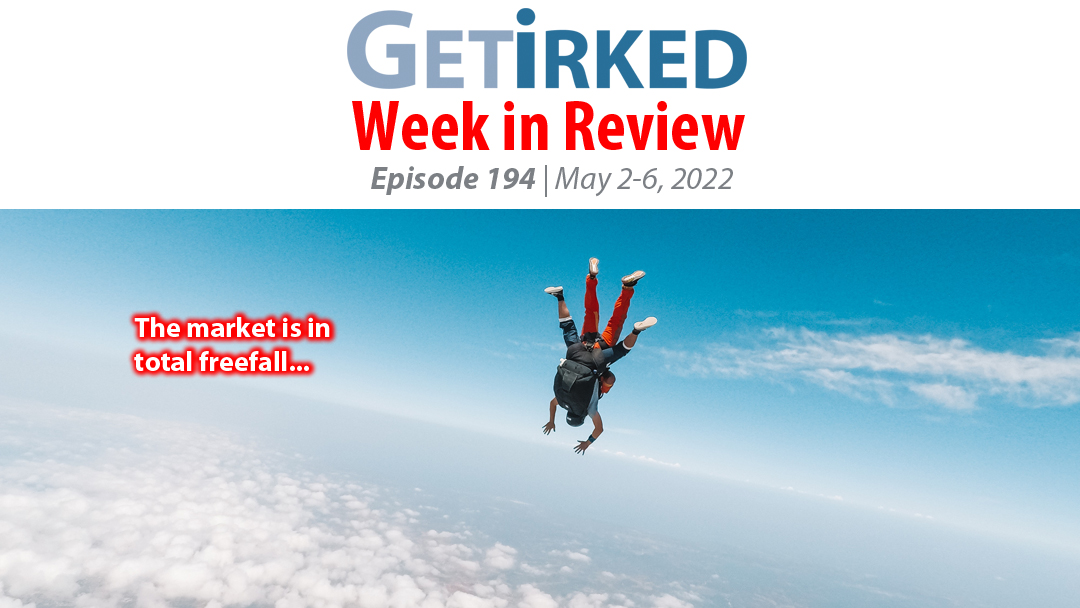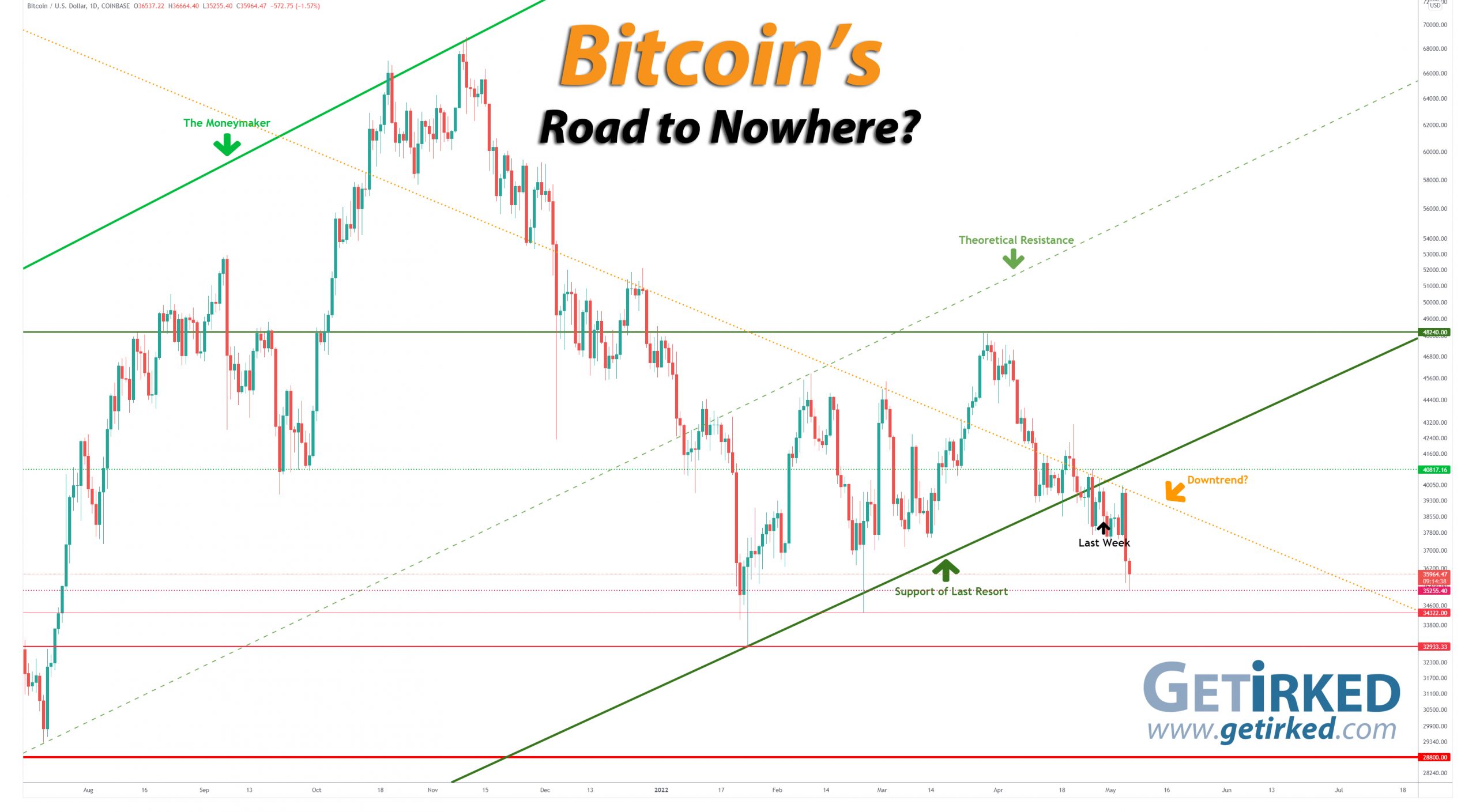Summing Up The Week
The wild volatility in the markets certainly continued, as promised, throughout the entirety of the week. Markets flip-flopped up until the Fed report on Wednesday, at which point it looked like they were headed higher.
That rally turned out to be a very false breakout as the entire market turned around and headed south in an epic fashion on Thursday, erasing all of the gains (and then some) that the markets saw on Wednesday.
Let’s look at the news that moved the markets this week…
Market News
Private payrolls increased 247K in April vs 390K expected
While investors eagerly awaited the results of the meeting of the Federal Reserve later on Wednesday, payroll processor ADP quietly released a report showing private payrolls increased only 247,000 versus the 390,000 expected by economists, reported CNBC. The reported figure also represented a significant decline from March, which saw a private jobs increase of 479,000.
“In April, the labor market recovery showed signs of slowing as the economy approaches full employment,” said ADP’s chief economist, Nela Richardson. “While hiring demand remains strong, labor supply shortages caused job gains to soften for both goods producers and services providers.”
The indexes rose despite the negative news, although this is likely a continuation of the “bad news is good news” thesis I talked about last week where investors hope signs of a weakening economy may slow the Fed’s aggressive approach to fighting inflation, a counter-intuitive thought, I know.
Fed raises rates +0.50% for first time in 20 years
Later on Wednesday, the Federal Reserve announced it would raise the benchmark interest rate by half-a-percentage point, as expected, to fight inflation, reported CNBC. Though, to most, this was the expected action the Fed would take, some analysts pondered whether the Fed might take an even more aggressive approach and raise the interest rate by 0.75%; as a result, the stock market rallied on the news.
The hike represents the first time the Fed has raised by 0.50% (typically, it raises by 0.25%) since 2000, with some analysts believing the rate hike to be historic and that it would serve as an indicator of exactly how much of an inflationary crisis the Fed sees for the U.S. economy.
In addition to the rate hike, the Fed acknowledged ongoing supply chain concerns, especially those due to China’s COVID-19 policy, “COVID-related lockdowns in China are likely to exacerbate supply chain disruptions. The Committee is highly attentive to inflation risks,” the Fed said in a statement released to the press.
Payroll grows 428K in April vs 400K expected
In yet another example of good news being bad news, the Labor Department reported that nonfarm payrolls grew 428,000 in April versus the 400,000 expected from Dow Jones’ estimates, reported CNBC.
“The job market continues to plow forward, buoyed by strong employer demand. After just over two years of the pandemic, the job market is remaining resilient and on track for a return to pre-pandemic levels this summer,” said Daniel Zhao, senior economist at jobs review site Glassdoor. “However, the job market is showing some signs of cooling as it turns the corner and the recovery enters a new phase.”
Following the free-fall death-drop in markets on Thursday, traders and investors were hoping for “relief” on Friday in terms of a disappointing jobs report, but that is not what they got… the economy is strong. As a result, the markets resumed their selloff.
Next Week’s Gameplan
Volatility is certainly here to stay for as long as the I can see, and with no real news catalysts in the future until the Fed’s next meeting in June, it’s likely we’ll see a lot of ups-and-downs throughout the upcoming weeks, especially with traders “leaving in May and going away.”
As always, if you find yourself bothered by the volatility or unable to ignore your portfolio, try to stop looking at it altogether. Don’t let the market’s wild gyrations affect the rest of your life – it’s fine to just leave your plan in place and go do something more important.
See you next week!
This Week in Play
Stay tuned for this week’s episodes of my two portfolios Investments in Play and Speculation in Play coming online later this weekend!
Crytpo Corner
Important Disclaimer
Get Irked contributors are not professional advisers. Discussions of positions should not be taken as recommendations to buy or sell. All investments carry risk and all readers must accept their own risks. Get Irked recommends anyone interested in investing or trading any asset class consult with a professional investment adviser to determine if an investment idea is suitable to them and their investment goals.Bitcoin Price (in USD)
%
Weekly Change
Bitcoin Price Action
Bitcoin Breakdown!
After what appeared to be a positive reaction to the Fed rate hike on Wednesday, it turns out that reaction was just a false breakout as Bitcoin broke down completely on Thursday, crashing through last week’s low of $37,700.00 before creating a new low at $35,255.40.
Bitcoin has been in such a consistent bearish cycle that I have once again adjusted the Downtrend? line to reflect the overall bearish view on the space.
The Bullish Case
Bulls like MicroStrategy (MSTR) CEO Michael Saylor continue to tout Bitcoin’s ability to hold up, nearly taunting the crypto by claiming any margin calls against the collateralized Bitcoin the company holds wouldn’t be triggered until $21,000 so they’re “pretty comfortable right now.” Apparently, Saylor, who has only been invested in Bitcoin since late 2020, doesn’t realize Bitcoin has the capability to sell off from already-oversold levels more than an additional -50% in a matter of weeks as it did in 2018.
The Bearish Case
Bears continue to maintain the upper-hand when it comes to the macro trend for Bitcoin. The new Downtrend? certainly doesn’t indicate anything positive in the near future for the crypto.
Bitcoin Trade Update
Current Allocation: 3.650% (+0.409% from last update)
Current Per-Coin Price: $39,154.50 (-0.325% from last update)
Current Profit/Loss Status: -8.147% (-7.694% from last update)
I made a few buys when Bitcoin sold off early in the week, resulting in an average buy price of $37,732.65 which lowered my per-coin cost -0.146% from $39,282.30 to $39,225.06 and increased my allocation +0.307% from 3.241% to 3.548%.
Then, after Bitcoin really collapsed on Thursday following the Fed’s rate hike, I made additional buys with an average price of $36,708.00 which lowered my per-coin cost an additional -0.180% from $39,225.06 to $39,154.50. The buys also increased my allocation an additional +0.102% from 3.548% to 3.650%.
Bitcoin Buying Targets
Using Moving Averages and supporting trend-lines as guides, here is my plan for my next ten (10) buying quantities and prices:
0.102% @ $34,824
0.171% @ $33,072
1.408% @ $30,015
1.491% @ $28,973
3.565% @ $25,620
4.687% @ $23,363
8.804% @ $20,983
3.411% @ $16,553
3.752% @ $13,690
4.093% @ $11,502
No price target is unrealistic in the cryptocurrency space – Bullish or Bearish.
While traditional stock market investors and traders may think the price targets in the cryptocurrency space are outlandish due to the incredible spread (sometimes a drop of near -90% or a gain of up to +1000% or more), Bitcoin has demonstrated that, more than any speculative asset, its price is capable of doing anything. Here are some of Bitcoin’s price movements over the past couple of years:- In 2017, Bitcoin rose +2,707% from its January low of $734.64 to make an all-time high of $19,891.99 in December.
- Then, Bitcoin crashed nearly -85% from its high to a December 2018 low of $3128.89. In the first half of 2019, Bitcoin rallied +343% to $13,868.44.
- From June 2019, Bitcoin crashed -54% to a low of $6430.00 in December 2019.
- From December 2019’s low, Bitcoin rallied +64% to $10,522.51 in February 2020.
- In March 2020, Bitcoin crashed nearly -63% to a low of $3858.00, mostly in 24 hours.
- Then, Bitcoin rallied +988% to a new all-time high of $41,986.37 in January 2021.
- Later in January, Bitcoin dropped -32% to a low of $28,732.00.
- In February 2021, Bitcoin rallied +103% to a new all-time high of $58,367.00.
- Later in February, Bitcoin dropped -26% to a low of $43,016.00.
- In April 2021, Bitcoin rallied +51% to a new all-time high of $64,896.75.
- In June 2021, Bitcoin crashed -56% to a low of $28,800.00.
- In November 2021, Bitcoin rallied +140% to a new all-time high of $69,000.00.
- In January 2022, Bitcoin crashed -52% to a low of $32,933.33.
What if Bitcoin’s headed to zero?
The only reason I speculate in the cryptocurrency space is I truly believe Bitcoin isn’t headed to zero. I am prepared for that possibility, however, by knowing I could potentially lose all of the capital I’ve allocated to this speculative investment. Professional advisers recommend speculating with no more than 5% of an investor’s overall assets. Personally, I’ve allocated less than that to speculating in crypto. I feel that anyone who doesn’t fully believe in the long-term viability of cryptocurrency would be better served not speculating in the space. On a good day, this asset class isn’t suitable for those with weak stomachs. On volatile days, the sector can induce nausea in the most iron-willed speculator. If a speculator isn’t confident in the space, the moves will cause mistakes to be made.


